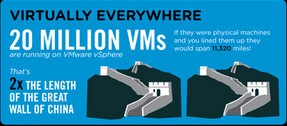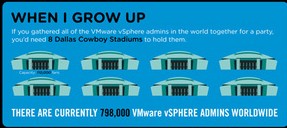 I’ve been interviewing several people to lead up the Virtualization group of my organization lately and one of the candidates asked me an excellent question, “Well, what do you mean by Virtualization?”. Very good question, am I talking about VMware, the hypervisor, virtualized infrastructure, what? Apparently I’m in a heretical mood these days because my answer was, “No, I don’t mean any of that, I don’t want to limit it to that. When I talk about Virtualization and what I want this team to focus on is bigger than that. Virtualization to me is technology enablement allowing IT to run the workloads you need to where you want to.”
I’ve been interviewing several people to lead up the Virtualization group of my organization lately and one of the candidates asked me an excellent question, “Well, what do you mean by Virtualization?”. Very good question, am I talking about VMware, the hypervisor, virtualized infrastructure, what? Apparently I’m in a heretical mood these days because my answer was, “No, I don’t mean any of that, I don’t want to limit it to that. When I talk about Virtualization and what I want this team to focus on is bigger than that. Virtualization to me is technology enablement allowing IT to run the workloads you need to where you want to.”
That distinction is important to me, and more importantly my customers. They NEED to run particular workloads in order to keep the doors open, to support the key processes required to run their business. They WANT to run those workloads where it makes sense to from an availability, or performance, or security, or even functionality perspective. Where they want to run that particular workload might change based on market conditions, or price of energy, or where the user has moved to, or because the security profile associated with it changed. It’s all about mobility. Now I know, technically, that doesn’t only require virtualization, and in some cases doesn’t even require virtualization, but that’s what customers are looking for, that capability. Virtualization used to be about consolidating many workloads onto one physical machine to optimize utilization of resources. That’s that first phase that many refer to on the journey to Cloud, consolidation of workloads. It’s an interesting concept to the CFO and CIO and in many instances the CISO, it’s not all that compelling to an end user or a line of business.
In my Cloud Heresy post I posited that we need to solve the business’s problems, this is a part of that. The key attribute of virtualization that’s getting the most traction with IT’s customers is mobility, sometimes referred to as agility. It’s about more than the hypervisor, but that’s the start. Why wouldn’t you put a hypervisor on every physical system? Why chain yourself to a machine, the overhead associated with the hypervisor isn’t that much any more and the benefits to agility, recoverability, &c. associated with it would outweigh the added cost in my opinion. Virtualized networks, storage, changing the perimeter for security from the network endpoints to the hypervisor are all components of enabling mobility in your enterprise. So, that’s the charge I’ve given my new Virtualization lead, continue to build out offerings and delivery capability to enable workload mobility for our customers.
On an unrelated note I was interested to see a cool new infographic from VMware about how vSphere is everywhere. I’m not sure I would’ve released all the information they did on it as some simple math reveals an interesting point. Two pieces of the graphic are below:
So there are 20 million VMs on vSphere, that’s awesome!
And there are 798,000 vSphere admins, outstanding!
Ooooh, wait a minute, that means each admin is responsible for an average of 28 VMs. Hmmm, that doesn’t sound so great. Let’s assume that 50% of those vSphere admins are geeks who have the certification but aren’t necessarily using it as a part of their job. Well, that still leaves an average of 56 VMs. Either we’ve got way too many admins, or we need to continue to push for more virtualization in our environments, or vSphere admins are managing many, many physical systems or other things in addition to their VMs. Would be interesting to find out more.



Usually I don’t read post on blogs, however I wish to say that this write-up very pressured me to check out and do it! Your writing taste has been amazed me. Thank you, quite great post.